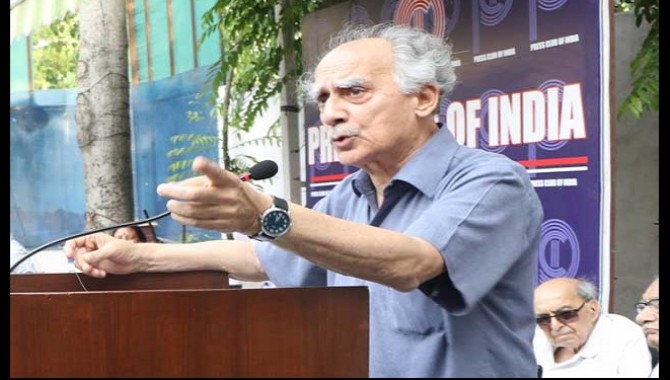Is our media under seige?
Ever since the raids on the NDTV promoters took place and the justifications and denials that followed, a recurrent question has cropped up----is our media under siege?
From press club podiums, through YouTube snippets and interviews, this question is being asked amidst an overarching defense by the establishment: has any media person been arrested or hounded? Even if that be the case, the counter is should the media be above law implying that the public ought to separate the reasons for such actions and not just scream that media freedom is under attack or invoke the catch phrase, the dark days of Emergency are here again.
With English language television channels squatting on stories and issues and anchors and panelists haranguing us on in what ways we should bare our nationalism, alternatives are the need of the hour.
Madhu Trehan’s interview with Arun Shourie and other views pertaining to the media’s shrinking critical faculties negates promising statistics about our robust media spread and growth. If the spread is not accompanied by media’s engagement with the diverse, plural and cultural views, then our understanding of media and democracy needs revision. Merely winning elections and forming a government does not warrant that a regime should be able to impose its policies and views on the media.
Newspapers and websites that are opening up debates are being asked to prove their nationalism or patriotism as it happened recently with the publication of the views of a social scientist, which caused a furore. What Madhu Trehan during the course of her interview with Arun Shourie referred to was the media monitoring exercise that classified journalists’ or media houses coverage as positive, neutral or unfavorable. Arun Shourie in a different frame in the interview responded that watching television news was futile. This reflects the disdain towards the medium and its orientation.
The Hindu, through the views of Krishna Prasad, Chandan Mitra, and Lawrence Liang addressed the “is the media under siege?” question with the views classified as left, right and centre. A difficulty that academics and other scholars--media not peers can do such assessment--face today is their views perforce have political overtones and cannot, therefore, be objective. The response to this dilemma comes from the counter that the erstwhile liberals cannot stomach the dynamics of a resurgent India and wallow in their sour grapes armchairs.
When Krishna Prasad makes reference to the employment/unemployment prospects of journalists he suggests that the mainstream media is in deep coma. This helplessness and its indirect impact on media functioning is of concern. Chandan Mitra counters the media-under-attack phobia by stating that it is fallacious and primarily stems from the inherent anti-BJP stance, particularly by the English language media. He indicts the media’s present attitude that seems to foreground upstart student leaders and their movements against the government. Lawrence Liang takes a reasoned view to suggest that the NDTV raids cannot be isolated or worked up to indicate that the media seizure is on. That NDTV has the ability to galvanize support (unlike smaller media outfits or journalists) also speaks of the power and influence of some reporters and a few media houses. He argues that the debate needs to open up on other fronts such as public’s right to screen and access films that may be against the grain.
Other snippets emerge between the stories such as the theory that a BJP spokesperson being asked to leave a show on the NDTV channel was a provocation for the reaction. Prannoy Roy’s speech exhorts that we need to stand up and not crawl. The need for a wake-up call was not missed in his speech. The regional language media could well be dealing with related issues. However, when the matter of either freedom of media or journalists’ paradigmatic shift is discussed through prism of English language media, a national discourse unfolds.
It is a different subtext when the larger question is raised of how the media content is being generated. From a district level reporter who also has to garner advertisements, through response management teams that frame and position the content, to a clutch of media owners whose political and economic interests influence macro issues of thought and democracy, to a small group of the so-called liberal journalists’ and their livelihood compulsions. In such tumultuous media terrain, we need to revisit the centuries’ old dictum of the so-called free and independent media.
It was post-Emergency that we witnessed a media boom in the print and particularly the magazine sector along with an exponential growth of television broadcasting. The common assumption was that except the broadcasting sector that was under State control the other media would sharpen their critical faculties to ensure that they will not be chained or crawl when only asked to bend. The political latitude that the media enjoyed along with a clear-cut separation of editorial and business aspects provided space for constructive or healthy criticism.
However, as media watchers would point out, media reforms post liberalisation meant primacy of political and economic agenda as a business practice. The trend of dovetailing media practices to those in power is the focus. The marked absence of the other or the proverbial voiceless is conspicuous. This may be the norm irrespective of changes in the power structure. That the skeletons only lie in the cupboards of a few who are equally powerful is something the viewer finds it difficult to swallow. The common man’s penchant for really wanting the law to take its course is tested as they continue to watch as couch potatoes.
Sanjay Bharthur teaches communication at the University of Hyderabad.
